Lots of new batteries (for mobile devices, MP3 players, etc) have connectors with 3 pins. I would like to know what is the purpose of this and how should I use these three pins?
They are usually marked as (+) plus, (-) minus, and T.
Lots of new batteries (for mobile devices, MP3 players, etc) have connectors with 3 pins. I would like to know what is the purpose of this and how should I use these three pins?
They are usually marked as (+) plus, (-) minus, and T.
The third pin is usually for an internal temperature sensor, to ensure safety during charging. Cheap knock-off batteries sometimes have a dummy sensor that returns a "temp OK" value regardless of actual temperature.
Some higher-end batteries have internal intelligence for charge control and status monitoring, in which case the third pin is for communications.
That third contact is connected to an internal thermistor, enabling the charger to measure the battery temperature.

In mobile phones, some Li+ battery packs have 3 terminals. Two possibilities:
If you want to explore what’s inside single-cell Li+ battery packs, look-up bq27000 gas gauge IC and associated application notes. Could be a good starting point.
Some packs have 4 terminals: positive, negative, SDA, SCL. The latter 2 lines are I2C or SMBus. Look up the bq27200 gas gauge IC (shares datasheet with bq27000).
EDIT: This was written as an answer to a duplicate question, which got merged with this one.
For Nokia batteries, one of the pins may be a BSI (Battery Size Indicator) pin, which contains a fixed resistor to ground, enabling the handset to identify which battery is connected. Examples of BSI resistor values include:
- BMC-2 3k3 NiMH 640mAh
- BMC-3 5k6 NiMH 900mAh
- BLD-3 22k Li-Ion 780mAh
- BL-4B 68k Li-Ion 700mAh
- BL-5B 75k Li-Ion 820mAh
- BL-4U 82k Li-Ion 1000mAh
- BL-5C 82k Li-Ion 1050mAh
- BL-4J 100k Li-Ion 1200mAh
- BL-5J 110k Li-Ion 1450mAh
See also: BSI - cpkb.org
The third pin is usually found on Li-Poly, or Lithium Polymer batteries and is required in order to charge the battery safely. Because these batteries are usually multi-cell, the third pin is used for balancing the charge between each of the cells.